Perennial flower bed for beginners
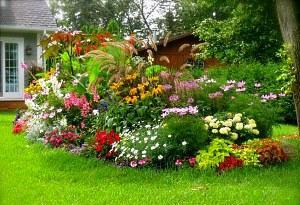 Landscaping is not an area where you can be guided solely by your own tastes. Without taking into account the all-season decorativeness, coloristic unity and exactingness to the cultivation of certain plants perennial flower bed decoration impossible. Do not rush into the pool with your head! Check out the most important principles of landscape design before decorating a perennial flower bed in your summer cottage!
Landscaping is not an area where you can be guided solely by your own tastes. Without taking into account the all-season decorativeness, coloristic unity and exactingness to the cultivation of certain plants perennial flower bed decoration impossible. Do not rush into the pool with your head! Check out the most important principles of landscape design before decorating a perennial flower bed in your summer cottage!
Flower gardens: definition and configuration
Flower beds are areas that combine decorative leafy, decorative flowering, herbaceous and shrub plants, garden paths and small architectural forms. They can be regular - with strict compositional lines, or landscape - with smooth outlines.
The sizes of flower beds are very different - from 1 square meter to 1000 square meters and more. The ratio of plants with small architectural forms and green lawns may also differ. The "golden ratio" is considered the one in which the first digit is greater than the second, and the sum of the first and second digits is equal to the third: 3: 5: 8; 8:11:19, etc.
According to the form and method of arrangement, flower beds are divided into subspecies:
- Modular flower beds
Flower gardens that combine green spaces, decorative paving (stones, tiles) and small architectural forms (vases, fountains and containers). - Mixborders
Mixed flower beds of any width and configuration. Most often they are a strip along the wall of a house, garden path or hedge. - Tapeworms
Flower beds, united according to some general principle: color, height of plants, shape of their leaves, etc. As a rule, they are placed in isolation, where they are best viewed. - Rabatki
Long, relatively narrow beds (the ratio of length to width is about three to one), monochromatic, or decorated with geometric patterns. They are often part of a complex perennial flower bed. - Curbs
Narrow (10-50 cm) continuous strips of compact, low-growing plants. Often used to border individual parts of a complex flower garden. - Rockeries
Flower gardens that combine plants and stones. Otherwise known as stone gardens. - Rock gardens
These are flower beds, the composition of which is based on plants of alpine and subalpine flora, planted on a hill.
Grouping plants
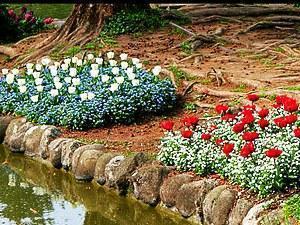 There are hundreds of species of perennial plants in the world, and they all have different requirements for growing conditions: some are unpretentious - some require regular care, some require abundant watering - some cannot tolerate excessive moisture ... Therefore, in order not to destroy others while caring for some plants, group them correctly! Also, consider your busy schedule. Consider how much time you are willing to devote to your floral arrangements.
There are hundreds of species of perennial plants in the world, and they all have different requirements for growing conditions: some are unpretentious - some require regular care, some require abundant watering - some cannot tolerate excessive moisture ... Therefore, in order not to destroy others while caring for some plants, group them correctly! Also, consider your busy schedule. Consider how much time you are willing to devote to your floral arrangements.
In general, perennials are subdivided into three groups according to their requirements: unpretentious, moderately laborious and laborious.
- Group. Perennial unpretentious flowers for a flower bed
This is a group of plants that are not demanding on light, moisture and soil type. They are resistant to diseases and pests, for many years they grow well in one place without transplanting, they are not afraid of cold weather. To maintain the beauty of a flower bed planted with unpretentious perennials, a minimum of time and effort is enough - watering during dry periods and annual spring processing.
There are a lot of plants in this group. This is aconite, brunner, gelenium, geranium (meadow and flat-leaved), gentian, doronicum, goldenrod, musk mallow, sedum, physostegia, purse, some types of poppies, etc. - Group. Moderately laborious flower bed flowers
This is a group of plants that do not require daily care, but need special growing conditions, as well as perennials, which should be planted every two to three years.
The second group includes aquilegia, armeria, arabis, cornflower, carnation, Gaillardia, geranium, gentian, delphinium lily (various hybrids). This also includes iris, clematis, macklea, large-flowered chamomile, bell, polyanthus rose, phlox, sage, echinacea. - Group. Laborious flowers for a flower bed
These are crops that require painstaking daily care, sophisticated agricultural techniques, and special growing conditions. Plants of the third group are susceptible to diseases, they are afraid of cold weather and various pests.
These are the majority of bulbs, lilies, roses, almost all gladioli, hyacinths, dahlias and chrysanthemums, begonia, kaempfer, evening primrose, etc.
Beautiful flower beds of perennials: tier planting
The layering (multilevel) of planting allows the owners of the garden plot to observe all the plants in an optimal decorative form, and the plants themselves - to receive the required amount of sunlight, without competing with each other.
Therefore, before planting, group all plants by height - give each group its own place:
If an oval or round perennial flower bed is arranged, then the tallest plants can be planted in the center. Plant medium-sized plants around them. Fill in the empty spaces with stunted ones. If we are talking about planting like mixboards, then plant tall plants in the background, and low ones in the foreground.
If desired, bring some tall plants to the fore or set aside for a single display. They will become the nodal points of the ornament. Avoid being straightforward. Experiment!
Planning work. Perennial flower bed scheme
Before you start planting plants, you need to draw a diagram of the flower garden on paper. A correctly drawn up perennial flower bed scheme is half the success of the entire event!
- Flower garden size
You should start with the distribution of the free area. Think about how much space you are willing to set aside for a flower garden. If you wish, use the "classic" proportion, according to which about 13% of the area should be allocated for a residential building and outbuildings, 20% for a utility yard and garden paths, 12-15% for a flower garden, 33% for a garden and 23% under the garden. - Flower garden contour
Decide on the desired shape and outline the outline of the flower garden. - Placing tall and low plants
Mark on the drawing a place for tall (80-150 cm), medium (40-70 cm) and low (up to 30 cm) plants. - Distance between plants
When drawing up a plan, keep in mind that most perennials grow in one place for years, which means that they need to leave free space "for growth." To prevent the flower garden from looking empty, you can temporarily fill in the gaps with beautiful annuals. - Color spectrum
In order to choose the right color scheme for the future flower bed, use pieces of colored paper, matching the tone of the selected plants. If you have no desire to cut and lay out paper "bushes" - paint the scheme with colored pencils. - Transferring the scheme "in kind"
It will be easier to transfer the site planning project "to nature" if you break the paper scheme into squares, and then, taking into account the accepted scale, "square" the earthen plot. You can outline the ground with a sharp peg or lime powder. After that, it will not be difficult to transfer all the lines of the circuit to the ground. It remains only to outline the points at which, according to the plan, certain plants will be located.
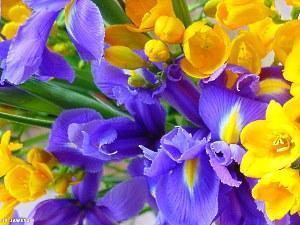
Coloristics
When creating flower arrangements, one should not forget about the basic rules of color harmony. After all, it is not for nothing that they say that the image of this or that garden determines the color by 99%.
Before starting work, study various photos of perennial flower beds and evaluate your feelings. Remember how these or those shades affect an outside viewer. Calculate everything to the smallest detail and make your choice!
Attention! The names of popular plants and the color of their flowers can be found in table 1.

"Seasons": continuous flowering flower bed of perennials
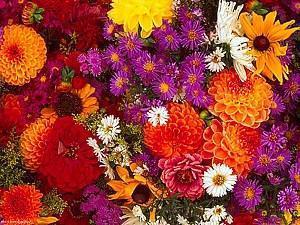 Unfortunately, plants that smell fragrant all year round do not exist in nature. Therefore, those who want to create a flower bed of continuous flowering need to use plants of various biological groups, clearly understanding which ones and when they look most effective. Difficulties often arise with this. After all, if there are no problems with achieving the flowering effect in the warm season (tall, medium and low-growing perennial flowers for the spring-summer flower bed are presented in a wide range in any store), then the selection of flowers for decorating the beds in the cold season often puts novice gardeners in dead end. There is an exit! We offer you our interesting variations on the theme "autumn-winter". Perhaps some of the ideas will find a place in your garden!
Unfortunately, plants that smell fragrant all year round do not exist in nature. Therefore, those who want to create a flower bed of continuous flowering need to use plants of various biological groups, clearly understanding which ones and when they look most effective. Difficulties often arise with this. After all, if there are no problems with achieving the flowering effect in the warm season (tall, medium and low-growing perennial flowers for the spring-summer flower bed are presented in a wide range in any store), then the selection of flowers for decorating the beds in the cold season often puts novice gardeners in dead end. There is an exit! We offer you our interesting variations on the theme "autumn-winter". Perhaps some of the ideas will find a place in your garden!
Autumn
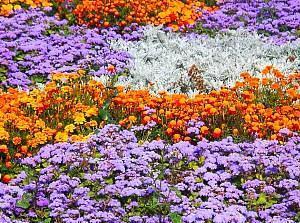 At the beginning of autumn, the garden will be decorated with medium and late varieties of phlox paniculata. By planting phlox in groups, and knocking them out with incense, you will receive a beautiful composition of perennials that require minimal maintenance.
At the beginning of autumn, the garden will be decorated with medium and late varieties of phlox paniculata. By planting phlox in groups, and knocking them out with incense, you will receive a beautiful composition of perennials that require minimal maintenance.
Perennial bulbs are also extremely good in autumn flower beds: botanical tulips of various varieties and their hybrids. From year to year they will grow, turning into large curtains.
Perennial plants for the flower bed, matched to the woody "cap", will look very beautiful against the background of autumn foliage: lemon-yellow goldenrod, orange rudbeckia, red-brown helenium.
Tall New England asters - one of the latest flowers - will form the basis of the garden composition in November. Due to the large number of "spare" buds in the inflorescence, they can easily withstand light frosts. Red, white, blue and pink, asters will not lose their decorative effect until the snow.
Winter
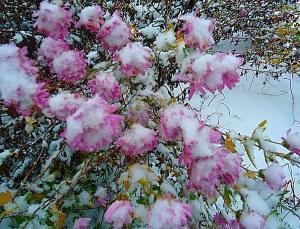 Beautiful flower beds of perennials of the "winter season" are not a fantasy, but a reality! There are really not many plants that are resistant to cold weather, however, among them there are some that have a strong emotional impact on a person!
Beautiful flower beds of perennials of the "winter season" are not a fantasy, but a reality! There are really not many plants that are resistant to cold weather, however, among them there are some that have a strong emotional impact on a person!
For example, such as the "queen of the east" chrysanthemums. Majestic, with bright double flowers, they are famous for extremely long flowering. The latest varieties of chrysanthemums begin to bloom in September and finish in the middle of winter (pictured: chrysanthemums in the snow).
When the fluffy snow falls, crocuses and crocuses will gaze upon themselves. Their colorful pink and lilac flowers can withstand severe frosts. Sprinkled with snow, they only slightly adhere to the ground, after which they straighten and stand again, as if nothing had happened.
Cyclamens bloom in mild winters from December to February. They are so beautiful that they even have an annual festival dedicated to them in England.
Ornamental shrubs will become a real symbol of the New Year. Just imagine the attractive power of scarlet cotoneaster fruits on a white blanket of snow, and you will certainly want to plant them in your garden. Happy creativity!
Video: how to make a mixborder with your own hands